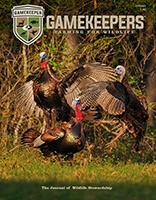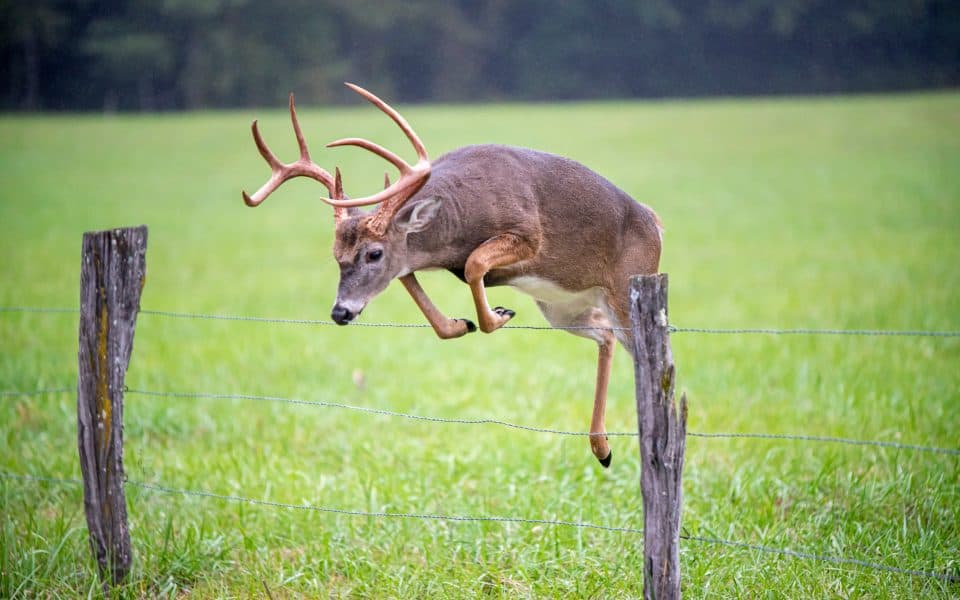Creating and maintaining food plots can be central to wildlife management and hunting success. Whether you’re aiming to attract deer, turkey, or other game, a successful food plot can dramatically improve wildlife presence. However, one of the biggest challenges some gamekeepers face is protecting those tender, succulent, extremely palatable plants during the early growth stages when they’re most vulnerable to over-browsing, or protecting them to save enough for attraction during the hunting season.
The Problem: Over-Browsing
The problem isn’t necessarily over-browsing; the root of the problem is having too many “eating machines” for the amount of available food. Food plots, especially those planted with high-protein forages like clover, soybeans, or brassicas, are irresistible to deer. While that’s why we plant the food (for the deer or other wildlife), it also presents a problem: they can destroy a plot before it has a chance to establish, or eat one down before the hunting season arrives. Young plants are especially susceptible during their early stages, and heavy browsing can lead to poor growth or complete failure of the plot.
There are three main solutions we can implement: remove some “mouths” (get busy killing does), increase the amount of food, or protect the food. In some situations, like heavily timbered areas or mountainous terrain, it might be difficult to plant enough ground, so increasing the amount of food might be challenging unless supplemental feeding is legal. It is also difficult on some properties to harvest enough does to keep the population from growing over where you would ideally like to have it. So without allowing the general public to hunt your property to help remove some numbers, protecting the food and “ringing the diner-bell” when you feel the crop can handle it may be your best solution.
Even small herds can do substantial damage in a short period of time. If a plot is completely eaten down before it matures, it won’t provide the nutrients or attraction it was intended for—effectively wasting your time, money, and effort.
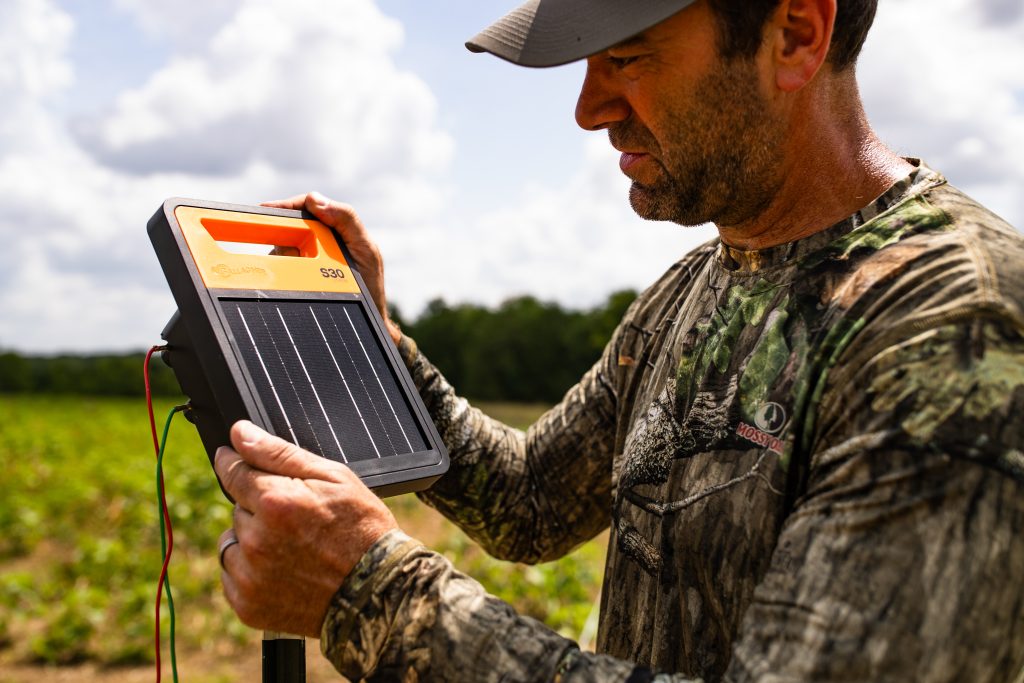
Mossy Oak
Solutions
Plot protecting sprays/ribbons, milorganite fertilizer, 12-volt battery powered scarecrows, propane cannons, temporary fencing, a permanent high-fence, or electric fencing can all be somewhat to totally effective at protecting a food plot. I would ask whether you believe this is a temporary problem or whether this will be ongoing? If it will be enduring, I would look at a permanent high fence, or my choice would be electric fencing.
Ribbons and sprays can work temporarily. I have tried these before with fair success. If I didn’t want to spend for an electric or permanent fence, this is the route I would suggest. The idea is to string a ribbon treated with a formula (the active ingredient is putrescent egg solids) around the area that you want protected. It smells horrible, I know why deer don’t like it. The same type of spray works when sprayed directly on the plants and can also be used for gardens. This system must be monitored closely because if one animal breaches your perimeter, the flood gates will have been opened. Often gamekeepers opt for using double strands of ribbon to help prevent a breach. I found another key to making this system work best is to never fence off your entire plot—always leave something for them. This way they are far less likely to violate your defense.
Milorganite fertilizer can also be somewhat effective. A University of Georgia study conducted by Odin Stephens tested soybean plots treated with Milorganite against untreated plots and found that significantly more plants survived when the fertilizer was applied. After three days, 54-percent of the untreated plants had been browsed, compared to only 24-percent of those treated with Milorganite. By day 20, 59-percent of the fertilized plants had been browsed, compared to 99-percent of the untreated ones. By day 30, all of the untreated plants had been browsed, while “only” 80-percent of the fertilized plants had been affected. Stephens recommended reapplying the fertilizer every 14 days for the best results.
Some of the other solutions are just plain silly like battery-powered scarecrows, unbelievably annoying like propane cannons, or very laborious like temporary fencing. If you have the dough to spend, a permanent high fence will get it done—you simply open the gate(s) when you feel like beginning the banquet. But remember, whitetails can jump a fence eight-feet high! So this can be expensive.
The Best Solution
Electric fencing, is in my opinion, the best solution. An electric fence can offer both a physical and psychological barrier to your plot. Once wildlife receives a memorable shock, they learn to avoid the fence altogether. Not only will these fences work on whitetails, but they will work on hogs, raccoons, and bears when erected properly.
Gallagher offers fencing systems specifically designed for protecting food plots. These systems make the most sense to me because they can be as permanent or as portable as you would like. They are cost effective, easy to set up, and even though they will teach an animal to avoid the spot they are a non-lethal deterrent.
The most recommended configuration for protecting food plots is the dual-fence system. This setup uses two parallel fences, typically about three-feet apart, to confuse and deter them from jumping over or pushing through. You will need:
- An Energizer: The heart of the system, converting battery or solar power into a high-voltage pulse.
- Posts: Insulated step-in or t-posts that support the wire.
- Conductive Wire or Tape: Gallagher offers high-visibility poly-wire or tape that carries the electrical current.
- Grounding System: Essential for a strong charge—requires ground rods properly installed in moist soil.
Fence Configuration
- Outer Fence: One or two strands at 15 and 24 inches high.
- Inner Fence: Two strands at 10 and 20 inches high.
- Distance Between Fences: Three-feet apart to confuse depth perception and reduce jumping likelihood.
This design creates a visual and physical deterrent that deer are reluctant to cross. Unlike a single strand or non-electric barrier, the dual-fence approach takes advantage of the animal’s natural caution, learning ability and limited depth perception.
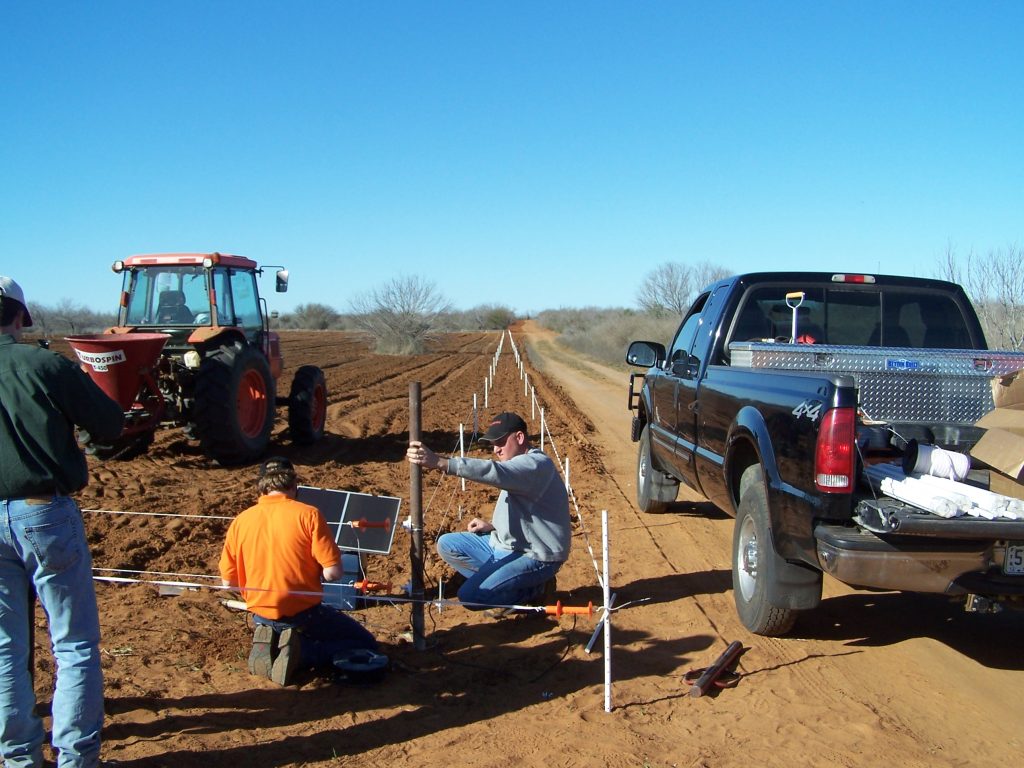
Gallahger Fences
Setting it Up
Step 1: Plan your plot. Determine the size and shape of your food plot. Measure the perimeter so you can calculate the amount of fencing material needed. Include an access gate or two for maintenance.
Step 2: Install posts. Place step-in posts around the perimeter, spacing them about 20 to 30-feet apart. Ensure the corners are well supported, using t-posts or braces if necessary.
Step 3: Run the wire. Run high-tensile wire or poly-wire/tape around the posts, setting the appropriate heights for each strand. Be consistent in spacing and tension to maintain effectiveness.
Step 4: Connect the energizer. Install the energizer in a secure location, ideally near a power source (or use a solar-powered energizer for remote areas). Connect the fence to the energizer and install the grounding system with galvanized rods.
Step 5: Test it and monitor. Use a voltage tester to confirm the fence is delivering a proper shock—typically at least 4,000 to 6,000 volts for deer. Test periodically, especially after storms, to ensure consistent operation.
Maintenance
Like any system, electric fences require periodic maintenance to stay effective. Check the voltage regularly to ensure the shock is strong enough to deter animals. Keep vegetation trimmed beneath the wires to prevent grounding and voltage loss. Inspect for damage—look for broken wires, fallen posts, or overgrown vegetation touching the wire, which can ground the charge. Recharge or replace batteries in solar energizers as needed. Snow also needs to be cleared if you’re continuing to use it into the winter months.
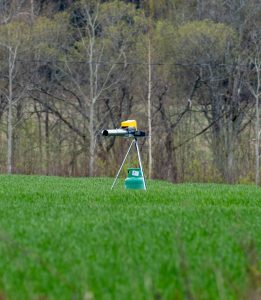
Edijs K
Ringing The Dinner Bell
When to remove or deactivate the fence is up to you. Gallagher fencing is ideal for seasonal use. Many landowners install the fence in spring or early summer when seedlings are most vulnerable, then remove or deactivate it in late summer or fall when plants are mature and can withstand browsing. Combine electric fencing with trail cameras to monitor plot usage and adjust timing for fence removal. This allows for more precise control over when and how wildlife access your food plots.
In some cases, land managers intentionally open access just before hunting season to create a sudden, highly attractive food source when it matters most. This strategy can be a game-changer, concentrating deer activity in a specific area. Where you have positioned your fence’s gate(s) will become great ambush spots. However, if the current isn’t flowing any longer they will learn that fairly quickly and can hop the fence anywhere.
While Gallagher fencing is most commonly used for deer, it can also deter other wildlife like raccoons, hogs, and even bears when configured properly. Different setups are available for different species, including lower strand placement or stronger energizers. Gallagher’s modular systems allow you to adjust your setup based on your unique wildlife pressures.
Cost Considerations & Final Thoughts
Gallagher fencing is relatively affordable, especially compared to the cost of failed food plots. A typical small plot (¼ to 1 acre) can be protected for a few hundred dollars, depending on energizer choice and fencing materials. For larger areas, costs scale up, but the investment pays off in food plot productivity.
If budget is a concern, start with one key plot and expand as needed. This fencing can be reused year after year, making it a smart long-term strategy. Many retailers offer full food plot protection kits that include everything you need to get started.
If you’re serious about maximizing the performance of your food plots, electric fencing is one of the best tools you can add to your wildlife management toolkit. It ensures your investment in seed, fertilizer, and time doesn’t go to waste due to early over-browsing.
The dual-fence system is particularly effective, and is easy to install and use even for beginners. With a little effort, you can protect your plots, attract more game, and elevate your gamekeeper-game to the next level.
Join our weekly newsletter or subscribe to Gamekeepers Magazine.
Your source for information, equipment, know-how, deals and discounts to help you get the most from every hard-earned moment in the field.
